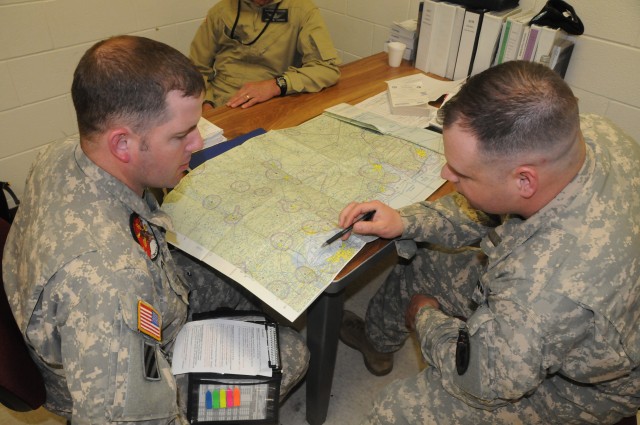
FORT RUCKER, Ala. -- "You can't teach old dogs new tricks" is an old saying, but staff here ignored the thought when they implemented Global Positioning System training in a senior Aviator course recently.
Staff from 110th Aviation Brigade and 1st Battalion, 223rd Aviation Regiment and Lear-Sigler Services, Inc., recently graduated Rotary Wing Instrument Flight Examiner Course students trained on GPS, according to Mark Wrinn, a 1st Bn., 223rd Avn. Regt. standards officer.
The seven-week course, which he calls the "Ph.D. course in Aviation," teaches senior pilots how to perform instrument check-rides. Every Aviator must undergo one instrument check-ride, a flight using only instruments and no visual cues, per year to remain certified, Wrinn said.
Wrinn said several reasons inspired Army and LSSI staff to include GPS training in the course, such as changes in technology and Federal Aviation Administration flight rules. Currently, helicopters use ground-based navigation aids, which emit radio signals, to keep pilots informed of their locations. By 2018, FAA officials will phase out these aids and begin using GPS systems fully, he said.
"Ground-based navigation aids are much more limited and not cheap to maintain," Wrinn said.
Student evaluations and crash data also encouraged the move to GPS training, he said.
He noted 75 percent of helicopter crashes involved weather or other environmental changes that caused a reliance on instrument flight rules, and pilots were not prepared for that.
To incorporate GPS into the IFE course, unit and LSSI staff first had to convince U.S. Army Aviation Center of Excellence and Training and Doctrine Command leaders change was needed, and then adapt the simulators and programs used in the training to include GPS instruction, Wrinn said.
In September, the first class received the training.
Maj. Paul Helten, a UH-60 Black Hawk and C-12 pilot with the North Dakota National Guard, said the course begins with Army instrument regulations and air traffic control procedures review before teaching students how to build approaches into the GPS system. The course also expands students' knowledge of how GPS systems work and the differences in the various types of GPS.
Students learning to become instrument flight examiners said adding GPS to the course was a necessary move, especially for pilots who fly overseas with few navigation aids.
"It is imperative that we get the GPS on board. It is life or death for us in the desert," said CW4 Stephanie Truax, a UH-60 Black Hawk pilot from 1st Battalion, 52nd Aviation Regiment, Fort Wainwright, Alaska.
She added that pilots currently only use GPS in sudden onset of adverse weather conditions or when escaping danger in theater, and being able to teach pilots how to use GPS effectively increases their chances of survival.
"This better prepares our Soldiers because they are going to be more comfortable with their equipment," Wrinn said.
Since pilots no longer have to follow vectors along ground-based navigation aid routes, Helten said GPS saves fuel and wear on helicopters.
Wrinn is a member of the Leading Change Team here, a group of individuals who seek to eliminate inefficiencies as part of The Big Opportunity begun by U.S. Army Aviation Center of Excellence and Fort Rucker Commanding General Maj. Gen. James O. Barclay III. He said the efforts of brigade and battalion personnel and LSSI are a prime example of what individuals can accomplish.
"This was a bottom-up change," he said, noting the group managed to overcome some difficulties to implement the training.
He said overcoming those obstacles can inspire others to tackle inefficiencies.

Social Sharing